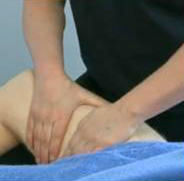Sports massage techniques for groin strain
The following sports massage guide is intended for information purposes only. Seek professional advice before attempting any self help treatment.
This article lists a number of massage techniques that assist in the the recovery from groin strain.
- The aim of sports massage is to release tension in the muscle and stimulate blood flow and healing.
- Massage must not be performed during the acute stage of this injury - usually 48 hours after injury. For grade two and three strains, massage may not be suitable for over a week. This is because if there is still bleeding(due to injury) then heat and massage will increase bleeding, not stop it.
Technique 1: Effleurage
Positioning the athlete in order the thoroughly massage the groin can be difficult. One method is to have the athlete on their back, with the knee bent and thigh rotated outwards, resting on a pillow.
Aim - light stroking to warm up the area in preparation for deeper techniques.
- With the hands stroke lightly but firmly upwards from just above the knee, to the upper thigh and groin area.
- Always stroke upwards towards the heart as this is the direction of blood flow. The other way can damage veins.
- Then lightly bring the hands down the outside of the leg keeping them in contact but do not apply pressure.
- Repeat the whole movement using slow stroking techniques, trying to cover as much of the leg as possible.
- Repeat this technique for about 5 to 10 minutes, gradually applying deeper pressure on the up strokes.
Technique 2: Petrissage
Aim - kneading movements to manipulate and loosen the muscle fibres more.
- With the hands apply a firm, kneading technique. Try to pull half the muscle towards you with the fingers of one hand whilst pushing half the muscle away with the thumb of the other hand.
- Then reverse to manipulate the muscle in the other direction.
- Work your way up and down the muscle, trying to cover the whole of the groin and thigh.
- Apply this technique for around 5 minutes, alternating with light stroking (above) occasionally.
Technique 3: Stripping the Muscle
Aim - to apply sustained pressure along the muscle, ironing out any lumps, bumps and knots.
- With the thumb of the right hand (for the right leg), apply deep sustained pressure along the full length of the muscle.
- This technique should be slow and deliberate to 'feel' the muscle underneath.
- Repeat this 3 to 5 times in a row, alternating with petrissage for 5 to 10 minutes.
- Massage should be deep but not so deep that the athlete tightens up with pain.
Technique 4: Circular Frictions
- If the therapist comes across any tight, tender knots in the muscle (usually at the point of strain or rupture), these can be worked out with deep circular frictions to the sore spot.
- Again ensure that the technique is not too paindul for the athlete.
Finishing Off
- The therapist can finish off with more petrissage techniques and then finally effleurage again. The whole process should not last more than half an hour.
- Massage therapy can be applied every day if it is performed lightly however deeper techniques may result in a days recovery period to allow tissues to 'recover'.
- For rehabilitation of muscle strains, sports massage is very important in softening / preventing scar tissue forming at the site of injury and re-aligning the new healing fibres in the direction of the muscle fibres. This may help prevent re-injury.
SPORTS INJURY CLINIC
http://www.sportsinjuryclinic.net/
See also:
»Newer topics:
»Older topics:
»
![]() Sports Massage Benefits and Effects
Sports Massage Benefits and Effects
list of massage benefits
![]() Sports Massage Benefits and Effects
Sports Massage Benefits and Effects
list of massage benefits
See also:
»Newer topics:
»Older topics:
»
![]() Sports Massage for Hamstring Strains
Sports Massage for Hamstring Strains
Sports massage can be used in the treatment of hamstring strain to help remodel the scar and increase the flexibility of the muscles.
![]() Sports Massage for Hamstring Strains
Sports Massage for Hamstring Strains
Sports massage can be used in the treatment of hamstring strain to help remodel the scar and increase the flexibility of the muscles.
See also:
»Newer topics:
»Older topics:
»
![]() Cold Therapy - Cryotherapy
Cold Therapy - Cryotherapy
Cold therapy or Cryotherapy is probably the most common first aid applied to sports injuries. Select the options below to learn more as well as less common uses of Cryotherapy.
![]() Cold Therapy - Cryotherapy
Cold Therapy - Cryotherapy
Cold therapy or Cryotherapy is probably the most common first aid applied to sports injuries. Select the options below to learn more as well as less common uses of Cryotherapy.




